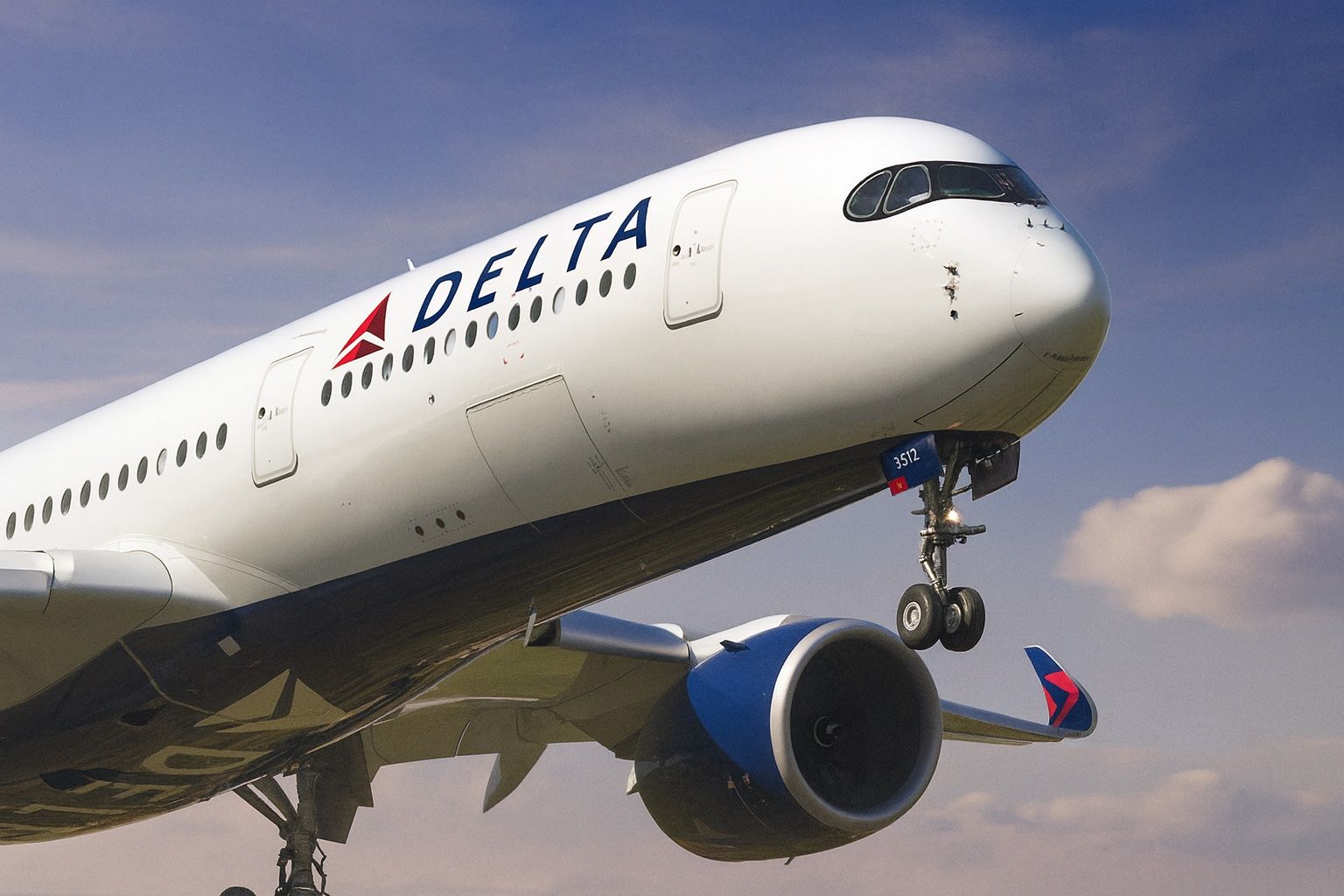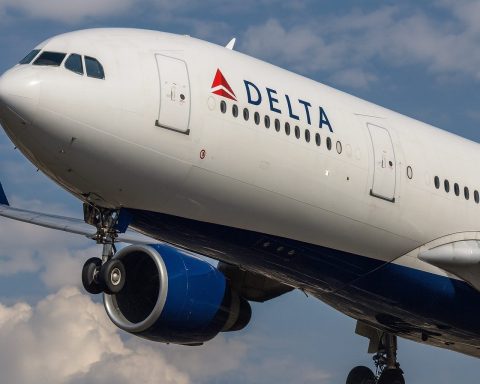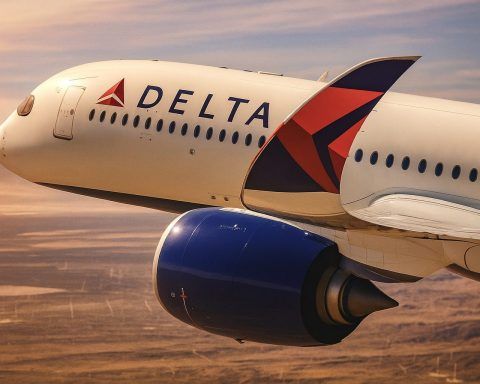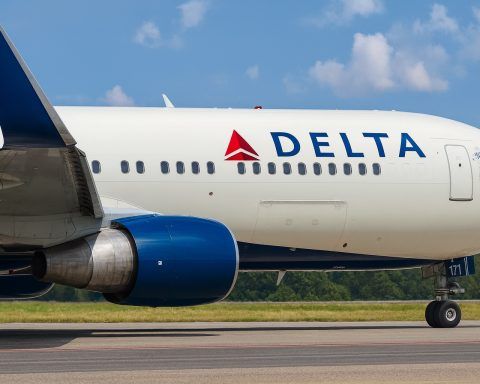- Costly Mishap: On Saturday, Oct. 25, a Delta Air Lines flight at Pittsburgh (PIT) was delayed nearly four hours after a flight attendant accidentally deployed the plane’s emergency evacuation slide just before departure [1] [2]. The slide inflated against the boarding bridge, effectively trapping passengers on board until it could be removed [3].
- Veteran Crew Error: The mistake was made by a lead flight attendant with 26 years of experience who inadvertently opened the front left door (1L) while it was still “armed” for emergency mode [4]. This split-second error triggered the automatic slide deployment. The flustered crew member immediately apologized, saying that in 26 years of flying “this never happened” before [5].
- Big Price Tag: Replacing an Airbus A220’s evacuation slide can cost $50,000–$70,000 [6]. Even just deflating, inspecting and repacking a deployed slide costs around $20,000–$30,000 in manufacturer fees [7] [8]. With the added expenses of hotel stays for misconnected passengers, crew overtime, and aircraft repositioning, the total cost of this incident will likely reach six figures [9].
- Stranded Passengers: Flight 3248 from Pittsburgh to Salt Lake City eventually departed around 9:11 p.m. instead of 5:30 p.m. [10]. Many travelers missed their connections in Salt Lake City and had to spend the night there due to the delay [11]. One passenger’s account on Reddit noted the attendant was “terribly sorry” and regretted everyone was “not going home tonight” as planned [12].
- Not as Rare as You’d Think: These accidents – officially called “Inadvertent Slide Deployments” (ISDs) – are uncommon but not unheard of. Airbus data indicates up to three slide deployments occur accidentally worldwide per day on average [13]. Most happen when a door is mistakenly left armed during arrival or departure, despite strict cross-check protocols [14].
- Safety Measures in Focus: Such incidents can be dangerous – a suddenly inflated slide can injure ground crew or damage equipment [15]. To prevent mishaps, some airlines have added extra safety steps. For example, British Airways introduced the Japanese “Shisa Kanko” point-and-call procedure for arming/disarming doors after a spike in slide incidents in 2023, which studies show can reduce human error by 85% [16]. Delta has not announced new measures yet, but aviation experts say this costly lesson underscores the need for strict adherence to procedures and continual training.
A Routine Departure Turns Chaotic on the Tarmac
Passengers aboard Delta Connection flight 3248 (operated by Endeavor Air) at Pittsburgh International Airport got a shock before takeoff when the plane’s forward evacuation slide suddenly burst out of the front door. The Airbus A220 was parked at gate D2, preparing for an on-time 5:30 p.m. departure to Salt Lake City, when the emergency slide unexpectedly deployed onto the jet bridge area [17] [18]. Crew members had just finished the standard pre-departure drill of arming the doors – a safety step that engages each door’s escape slide for automatic inflation if opened in an emergency [19].
According to reports, a senior flight attendant at the 1L door made a split-second mistake that set off the slide. Immediately after the captain’s command to “arm doors for departure,” this lead attendant apparently tried to double-check or adjust the door and raised the door handle while the door was still armed [20]. In a properly armed door, even a slight lift of the handle triggers the emergency power-assist mechanism – the door springs open and the inflatable slide erupts out in seconds [21] [22]. That is exactly what happened: the slide blasted out and fully inflated, wedging itself between the aircraft and the jetbridge. There was no stopping it once it began – as one aviation safety writer notes, with the system armed “any movement of the door handle is enough to trigger” deployment, and once triggered, the slide will force the door open whether you want it to or not [23].
Crewmembers and passengers alike were stunned. One moment the cabin was ready for pushback; the next, they heard the loud whoosh of the slide inflating. “Oopsie. We all make mistakes, but this is a really expensive one,” one observer quipped on a travel forum [24]. The veteran flight attendant who committed the error was mortified – by eyewitness accounts, he was visibly flustered and kept apologizing to everyone on board [25]. He even made a PA announcement to apologize, reportedly saying he was “terribly sorry” and that in over two decades on the job he’d never experienced this kind of mishap [26].
Passengers Trapped and a Four-Hour Delay
When an evacuation slide deploys accidentally at the gate, it creates an immediate operational mess. In this case, the slide ballooned out right into the boarding bridge, pinning it in place [27]. The aircraft effectively could not be moved, and because the slide was blocking the exit, passengers were temporarily trapped on board [28]. The crew had to radio for ground engineers, who came and carefully deflated and detached the giant slide. Only after about an hour of effort could the jet bridge be re-connected to let passengers off the plane [29] [30].
The flight, originally scheduled to depart in the early evening, didn’t take off until 9:11 p.m. local time [31]. That ~3.5 to 4-hour delay meant the flight arrived in Salt Lake City far behind schedule. As a result, dozens of travelers missed their onward connections that night [32]. Delta had to arrange hotel accommodations for many stranded passengers in Salt Lake City and rebook them on flights the next morning. “No going home tonight,” as the apologetic flight attendant grimly put it [33]. What was supposed to be a routine trip turned into an overnight ordeal for some customers.
Delta Air Lines has not publicly detailed this incident, but industry reports and passenger posts online have painted a clear picture of what transpired [34] [35]. Importantly, no one was injured by the slide deployment – a bit of luck, since an erupting slide can be hazardous if anyone is in its path. (In this case the slide shot out into the empty jetbridge, not into ground crew on the tarmac.) Once the situation was under control, Delta brought in a replacement slide or took the plane out of service for repairs, and flight 3248 eventually continued on its way late that night.
Why a Simple Door Mistake Is So Serious
This incident underscores a peculiar paradox of airline safety: the very systems designed to save lives in a crash can wreak havoc if triggered at the wrong time. Emergency evacuation slides are marvels of engineering – in a genuine emergency, they inflate within seconds to allow rapid evacuation of passengers. To make them foolproof in crises, manufacturers intentionally make slides deploy automatically whenever an armed door is opened [36], with no extra button presses or confirmations required. “In an emergency, you want ‘open door = slide goes’ with zero extra steps,” travel expert Gary Leff explains [37]. That quick-trigger design saves precious seconds during evacuations. But it also means that any inadvertent opening of a door in armed mode will immediately fire the slide, as happened in Pittsburgh.
Airlines have strict procedures to prevent these accidents. Anytime a plane leaves or approaches a gate, flight attendants perform a ritual: arming the doors before departure, then disarming them upon arrival, always cross-checking one another’s work. On most aircraft, two crew members will verify each other’s door status to make sure no door is left armed by mistake [38]. This makes accidents rare, but not impossible – human error or miscommunication can creep in. On smaller jets like the A220, the lead flight attendant at the front may have to cross-check their own door without a second person, which leaves more room for oversight [39] [40]. In Saturday’s case, it appears the door was armed properly for departure – but then a momentary lapse (re-opening the door internally, perhaps to resecure it) caused the slide to deploy [41].
Analysts note that even well-trained, long-time crew can slip up. “Why would the flight attendant grab that huge handle and move it to OPEN… with the jet still connected?” one commenter (a fellow crew member) wondered aloud, puzzled that a 26-year veteran made such a basic error [42]. Fatigue, distraction, or stress could be factors, though the exact reason remains unclear. Delta has not indicated whether it will require additional training or procedural changes after this incident [43], but it’s likely to be an internal lesson learned. In fact, anecdotes from airline training suggest that when slide mishaps occur, they often become case studies in future recurrent training sessions – a somewhat embarrassing fate for the crew involved, but a teaching tool to prevent repeats [44] [45].
The $70,000 Slide and Six-Figure Bill
Beyond the operational chaos, an accidental slide deployment carries a hefty financial cost. Industry experts estimate that a brand-new replacement slide for a small jet like the Airbus A220 runs $50,000 to $70,000 [46]. If the deployed slide can be salvaged, it must be painstakingly deflated, inspected, repacked, and certified by the manufacturer – a process that still costs on the order of $20,000 or more [47] [48]. (Paddle Your Own Kanoo, an aviation site, notes the repack fee is around $30,000 for an A220 slide, due to specialized handling and inspection requirements [49].)
Delta hasn’t confirmed the exact figure, but multiple reports put the immediate damage at around $70,000 just for the equipment and repairs [50] [51]. And that’s only part of the picture. Consider all the ripple effects: a delayed flight means potential crew overtime pay and possibly timing out some crew members. Dozens of passengers needed last-minute hotel rooms and meal vouchers in Salt Lake City because they missed connections [52]. Some may have been rebooked on other airlines, incurring additional costs. The aircraft involved might have lost its next rotation or needed a repositioning flight after being stuck in Pittsburgh for slide removal. All told, such an event can easily rack up a total expense well into six figures by the time the operation recovers [53]. One source dubbed it a “$100,000 mistake” when factoring in all the knock-on costs [54] [55].
It’s worth noting that these unplanned costs, while painful, are not devastating to a large airline’s bottom line. Delta Air Lines is a $50+ billion company that recently posted $1.42 billion in profit for Q3 2025 amid booming travel demand [56]. A six-figure incident is more of an embarrassment and logistical headache than a financial blow in that context. Still, no airline welcomes avoidable losses and service disruptions. Each slide deployment incident also comes with the paperwork and investigations required for safety compliance – another overhead cost. Delta will surely examine how this happened and look for ways to prevent a repeat, whether through refresher training or tweaks to procedure.
Inadvertent Slide Deployments: Rare but Real
While the Pittsburgh incident made headlines for its dramatic twist, accidental slide deployments are a known hazard in aviation. They even have a formal name: Inadvertent Slide Deployments (ISDs). Airlines track ISDs as a safety metric, and regulators pay attention because of the risk they pose. How often do they happen? Airbus data from a few years ago suggested an average of up to 3 inadvertent slide deployments per day worldwide [57]. Considering the thousands of flights operating each day, that frequency is extremely low – but it does mean these mishaps occur on occasion across the industry. “ISDs are uncommon but not rare,” as one report put it [58].
Crucially, most ISDs happen on the ground and at fairly low stakes times: typically after landing. A classic scenario is a flight attendant at the arrival gate forgets their door is still armed (or mishears the disarm call) and opens the door from the inside, deploying the slide to everyone’s surprise [59]. It can also occur, as in Delta’s case, before departure if a door is reopened after being armed. The industry’s built-in defense is the cross-check – every arming/disarming action is verified by a colleague – but human errors can slip past, especially when someone is working alone or gets momentarily distracted [60] [61].
The consequences of an ISD range from costly to downright dangerous. In the best case, it’s an empty aircraft or gate area and only money is lost. In worse cases, a deploying slide can hit and injure ramp workers, or cause serious damage by striking the jetbridge or a service truck [62]. There have been freak accidents: in 2019, a Delta slide fell out of a plane on approach and landed in a suburban backyard in Massachusetts (thankfully hurting no one) [63]. In another incident, an evacuation slide detached from a Delta jet in flight over New York and had to be retrieved on the ground [64]. These are exceedingly rare, but they highlight why airlines treat any slide mishap as a significant safety event.
Preventing “Oops” Moments: Training and New Procedures
For airlines, every ISD is a teachable moment. Carriers continually update training and procedures to guard against door-arm mistakes. Delta, for example, reportedly gives remedial training to crews involved in slide incidents and emphasizes adherence to the “arming/disarming” verbal checklist during every flight [65] [66]. Cabin crew are trained to speak aloud (“Door 1L disarmed, cross-checked”) and confirm their colleagues’ actions, creating redundancy in the process. The goal is that even a forgetful moment by one person will be caught by another – though this method isn’t foolproof if all involved are rushed or distracted.
In 2023, British Airways made headlines by adopting an unusual technique to reduce errors after the airline saw a spike in slide deployments. BA introduced the Japanese practice of “Shisa Kanko,” which means “point and call” [67]. This ritual – borrowed from Japanese rail and manufacturing safety culture – has crew members physically point at a door’s arming lever and verbalize the status (“Door 1L disarmed”) as they perform the task. It may look odd, but studies show this method dramatically boosts focus. The Japanese Railway Institute found pointing-and-calling can cut mistakes by nearly 85% [68]. British Airways incorporated it for critical steps like door arming, hoping to eliminate the kind of complacency or mind-slip that leads to accidents. Early feedback suggests it’s helped staff maintain attentiveness during routine but crucial safety checks.
Other airlines are watching such experiments closely. There is often a push-pull between adding extra safety checks and maintaining efficiency. Some veteran crew initially resist new rituals as feeling overly gimmicky, but many come around when they see the safety stats improve. Whether Delta will consider “point and call” or other added checks isn’t known, but this incident in Pittsburgh will surely feed into the industry’s ongoing discussion about human factors. As one safety bulletin dryly noted, even the most experienced crew can benefit from a reminder that “arming a door” is a step that demands 100% concentration every single time.
An Expensive Lesson for Delta, But Business as Usual
For the passengers delayed and the crew involved, the accidental slide deployment was a memorable ordeal. Such an incident combines inconvenience, embarrassment, and expense – a trifecta any airline would prefer to avoid. The story has garnered attention precisely because it’s a bit of an aviation oddity: it involves neither crash nor injury, yet illustrates how a momentary lapse can spiral into a night’s worth of trouble and tens of thousands of dollars gone.
Delta Air Lines will recover from this stumble without much trouble. The carrier is financially strong (it just announced record quarterly earnings in October) [69] and enjoys high operational reliability overall. In fact, many travelers likely never hear about these slide incidents unless they’re directly affected. But within airline circles, each occurrence is taken seriously. The Pittsburgh slide blowout will prompt internal reviews and a refresher for Delta’s 20,000+ flight attendants about the importance of door arming protocols. As one commenter noted, “we all make mistakes, but this is a really expensive one” [70] – the kind of mistake airlines are investing big efforts to eliminate.
Bottom Line: A long-serving Delta flight attendant’s one slip-up caused an overnight disruption and a massive bill, but also provided a real-world case study in why redundant safety checks exist. It’s a reminder that even in today’s highly automated aviation world, human factors remain critical. As costly as this incident was, the silver lining is that no one was hurt and it may spur even tighter safety measures to ensure the slides only deploy when and where they’re truly needed [71] [72].
Sources: Delta flight attendant slide incident reports [73] [74]; industry expert commentary on slide costs and procedures [75] [76]; Airbus safety data on inadvertent deployments [77]; British Airways point-and-call error reduction info [78]; passenger accounts from Reddit and news outlets [79] [80]; Delta financial performance context [81].
References
1. www.livemint.com, 2. viewfromthewing.com, 3. www.paddleyourownkanoo.com, 4. www.livemint.com, 5. viewfromthewing.com, 6. www.paddleyourownkanoo.com, 7. www.paddleyourownkanoo.com, 8. viewfromthewing.com, 9. viewfromthewing.com, 10. viewfromthewing.com, 11. viewfromthewing.com, 12. www.paddleyourownkanoo.com, 13. aviationa2z.com, 14. aviationa2z.com, 15. www.paddleyourownkanoo.com, 16. aviationa2z.com, 17. viewfromthewing.com, 18. viewfromthewing.com, 19. viewfromthewing.com, 20. viewfromthewing.com, 21. www.paddleyourownkanoo.com, 22. www.paddleyourownkanoo.com, 23. www.paddleyourownkanoo.com, 24. viewfromthewing.com, 25. www.paddleyourownkanoo.com, 26. www.paddleyourownkanoo.com, 27. www.paddleyourownkanoo.com, 28. www.paddleyourownkanoo.com, 29. viewfromthewing.com, 30. viewfromthewing.com, 31. viewfromthewing.com, 32. viewfromthewing.com, 33. www.paddleyourownkanoo.com, 34. www.livemint.com, 35. www.paddleyourownkanoo.com, 36. viewfromthewing.com, 37. viewfromthewing.com, 38. www.paddleyourownkanoo.com, 39. www.paddleyourownkanoo.com, 40. www.paddleyourownkanoo.com, 41. viewfromthewing.com, 42. viewfromthewing.com, 43. aviationa2z.com, 44. www.reddit.com, 45. www.reddit.com, 46. www.paddleyourownkanoo.com, 47. viewfromthewing.com, 48. www.paddleyourownkanoo.com, 49. aviationa2z.com, 50. aviationa2z.com, 51. www.livemint.com, 52. viewfromthewing.com, 53. viewfromthewing.com, 54. viewfromthewing.com, 55. viewfromthewing.com, 56. ts2.tech, 57. aviationa2z.com, 58. aviationa2z.com, 59. aviationa2z.com, 60. aviationa2z.com, 61. aviationa2z.com, 62. www.paddleyourownkanoo.com, 63. viewfromthewing.com, 64. viewfromthewing.com, 65. www.reddit.com, 66. www.reddit.com, 67. aviationa2z.com, 68. aviationa2z.com, 69. ts2.tech, 70. viewfromthewing.com, 71. www.paddleyourownkanoo.com, 72. aviationa2z.com, 73. www.livemint.com, 74. aviationa2z.com, 75. www.paddleyourownkanoo.com, 76. viewfromthewing.com, 77. aviationa2z.com, 78. aviationa2z.com, 79. www.paddleyourownkanoo.com, 80. viewfromthewing.com, 81. ts2.tech










